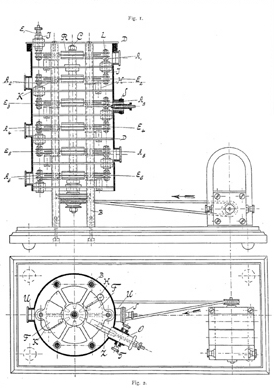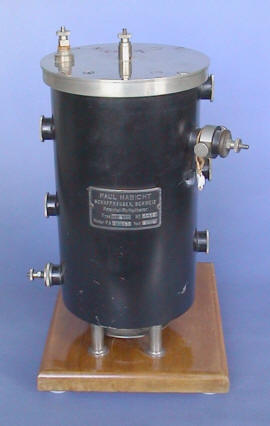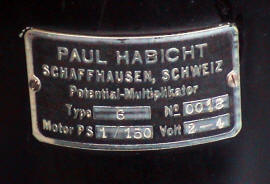“I herewith friendly invite you that we together make the final tests with the Maschinchen & write the essay.”
Albert Einstein in a letter to Conrad Habicht, March 4, 1910
The “MASCHINCHEN”
Already in his youth Einstein developed interest in technical tasks and their solutions. This was probably owed to his father (Hermann Einstein, 1847-1902) and his uncle Jakob (Jakob Einstein, 1850-1912) who were long time owners of an electrotechnical company.
This interest shows in the different technical projects Einstein was busy with over the years. In some cases there were even patents awarded, however, always together with a partner.

One of these technical tasks was the device Einstein in his letters often lovingly described as “Maschinchen”. What is meant here is an “electrostatic potential multiplier” with which it should be possible to measure even smallest voltage differences of half a millivolt through the combination of an “air capacitor consisting of mobile plate systems which were pushed into each other with a multiplier”. The amplification of the very small initial voltage was realized “via electrostatic induction and electrometric measurement of the final voltage.
Einstein’s basic considerations concerning the development of the Maschinchen can be traced back to two of his works from the year 1905. On the one hand he hoped that his Maschinchen would prove his predictions concerning the theory of Brownian motion. On the other hand he wanted to check the equivalence of mass and energy (E=mc²) with the help of research in the field of radioactivity.
In April 1908 Einstein published his invention in volume 7 of the Physical Journal on the pages 216-217 in an article with the title “A new electrostatic method for the measurement of smallest amounts of electricity“ („Eine neue elektrostatische Methode zur Messung kleinster Elektrizitätsmengen“), which also contained first basic depictions of the Maschinchen. In the article Einstein writes among other things: “… As the improved sensitivity of the electrostatic measuring methods is of importance for the research in the field of radioactivity I hope that a physicist will be interested in the matter as I would like to discuss my further considerations concerning the object with him. This plan developed as I was thinking about the fact how the spontaneous charges of conductors which are demanded by the molecular theory of heat and which are analogous to the Brownian motion can be verified and measured. I hope to have helped solving also this problem with the described plan.“ („… Da die Erhöhung der Empfindlichkeit der elektrostatischen Meßmethoden von Bedeutung ist für die Erforschung der Radioaktivität, hoffe ich, daß sich ein Physiker für die Sache interessieren wird. Meine weiteren Überlegungen über den Gegenstand würde ich demselben gerne mitteilen. Auf den vorliegenden Plan wurde ich geführt durch Nachdenken darüber, wie die von der Molekulartheorie der Wärme geforderten, der Brownschen Bewegung analogen spontanen Ladungen von Leitern konstatiert und gemessen werden könnten. Auch dieses Problem hoffe ich mit dem geschilderten Plane seiner Lösung um einen Schritt näher gebracht zu haben.“)
Already in 1907 Einstein discussed his ideas with the brothers Conrad (1876-1958) and Paul Habicht (1884-1948) who only after a few weeks built a first, however still deficient prototype together with their mechanic. In August 1907 he wrote to Bern in a letter to the brothers: “Dear Habichte! I am utterly amazed about the immense speed with which you built the Maschinchen. I will visit you on Sunday. …” In the following years they spent much time with the construction and assembly of the Maschinchen. Successes and failures constantly changed. This is was Paul Habicht wrote to Einstein in October 1908: “… Your Maschinchen is finished, however, when switching to self-excitation I am not able to bring about any spark. So there must be something wrong. … Maybe the sealing wax is not insulating or covered with a conducting layer. Well, we will see. …” In a letter dated April 1909 Einstein reported to Conrad Habicht positive results of his examinations: “… Until Saturday I will have an electroscope which allows an estimation of 1 volt. The Maschinchen transmits 2* 105 times. …” Five months later, in September 1909, he asked Conrad in a letter: “… How is the Maschinchen? Where do the mistakes begin?” and in December 1909 he writes in a letter to Conrad: “… Paul does good work assembling the Maschinchen. …” In March 1910 he writes to Conrad: “… You have now improved the Maschinchen to a high degree; I hope you will be successful with it. …”
In connection with the development of the Maschinchen Einstein among other things also had contact to the physicists Joseph Kowalski (1866-1927) and Albert Gockel (1860-1927), both of the University of Fribourg in Switzerland. He also had contact to Edouard Guillaume (1881-1959) who at that time was working at the Bern patent office as technical expert second class.

In March 1910 Einstein and the Habicht brothers tested the Maschinchen and together wrote a technical description. For this reason Einstein wrote to Conrad on March 4: “… I herewith friendly invite you that we together make the final tests with the Maschinchen & write the essay. This must be done now so that no other person does it. …” The essay which was “written” in this way was published in the Physical Journal 11 (1910) on the page 532-535 with the title “Electrostatic potential multiplier according to A. Einstein.” (“Elektrostatischer Potentialmultiplikator nach A. Einstein”). Only Conrad and Paul Habicht were named as authors.
In December 1911 a prototype of the Maschinchen was successfully demonstrated by Paul Habicht to the Berlin Physical Society (later German Physical Society). Einstein was optimistic and believed in the success of the Maschinchen. Some days later he wrote to his friend, the physician Heinrich Zangger (1874-1957): “… Habicht recently held a lecture to the Berlin Physical Society with an explanation of the Maschinchen and had lots of success with it. Now he has overcome the resistance against this matter; I think that the Maschinchen will soon have replaced the sensitive quadrants & filament electrometer. …” However, this should not happen.
In the end the electrostatic potential multiplier, Einstein’s Maschinchen, did not have success. Until the 1930ies only few samples were assembled and sold in the workshop of Paul Habicht in Schaffhausen. The handling of the Maschinchen proved itself as impracticable. Physicists used other, more efficient and more powerful instruments for their purposes. One sample which was bought by the German physicist Friedrich Paschen (1865-1947) around 1920 can be seen today in the Physical Institute of the University of Tübingen.

Illustrations Credits:
Dr. Torsten Hehl, Tübingen: 1, 2
Bibliography:
| Albert Einstein | Eine neue elektrostatische Methode zur Messung kleinster Elektrizitätsmengen Physikalischen Zeitschrift 7 (1908) Seite 216-217 | 1908 |
| Conrad Habicht, Paul Habicht | Elektrostatischer Potentialmultiplikator nach A. Einstein Physikalische Zeitschrift 11 (1910), Seite 532-535 | 1910 |
| Ann M. Hentschel, Gerd Graßhoff | Albert Einstein “Jene glücklichen Berner Jahre” | Bern 2005 |
| Hrsg. John Stachel, a.o. | The Collected Papers of Albert Einstein, Volume 2 | Princeton 1989 |
| Hrsg. Martin J. Klein, a.o. | The Collected Papers of Albert Einstein, Volume 5 | Princeton 1993 |
| József Illy | The Practical Einstein: Experiments, Patents, Inventions | Baltimore 2012 |
| Friedemann Rex | Einsteins Maschinchen | Tübingen |


 DEUTSCH
DEUTSCH